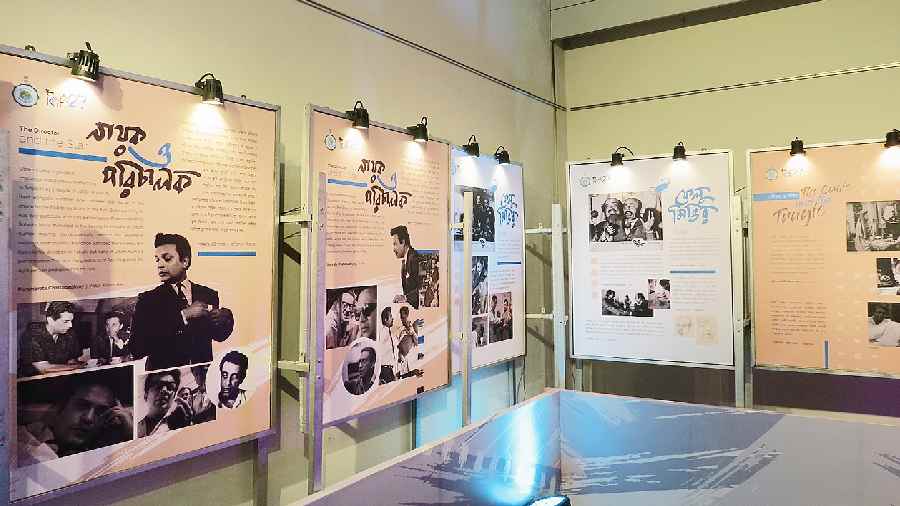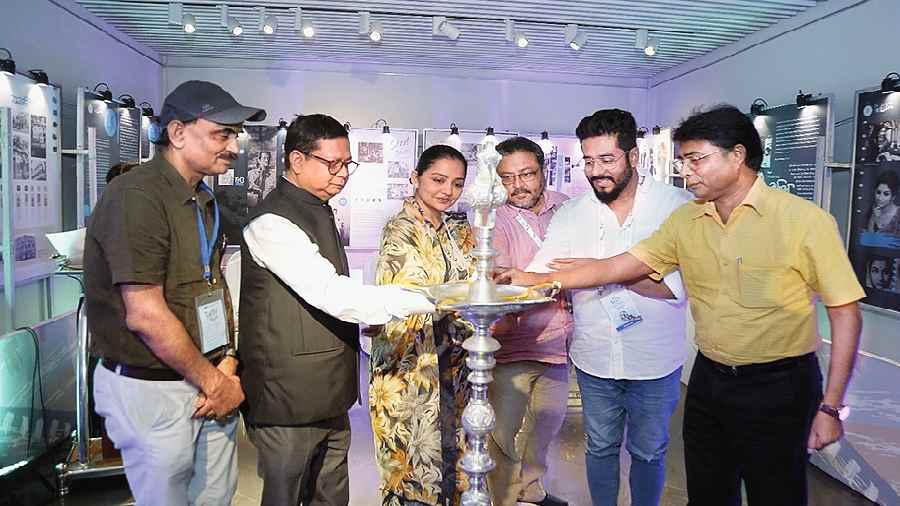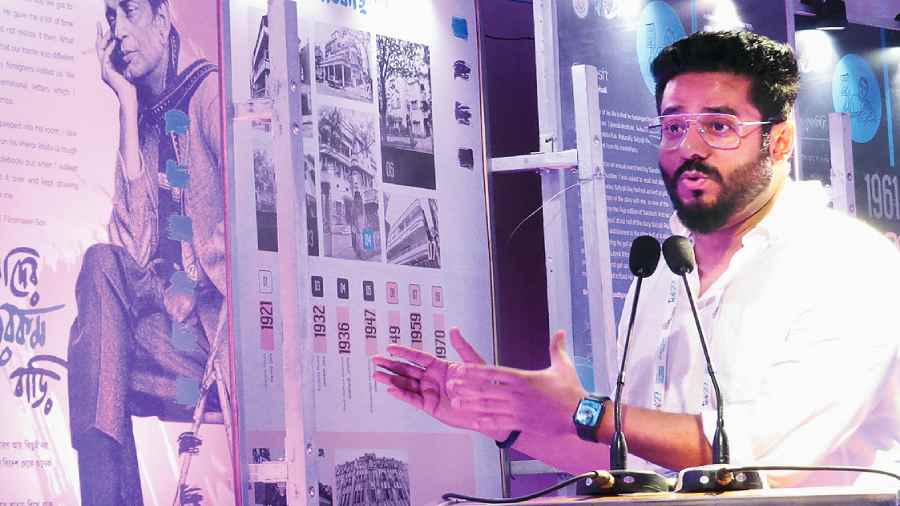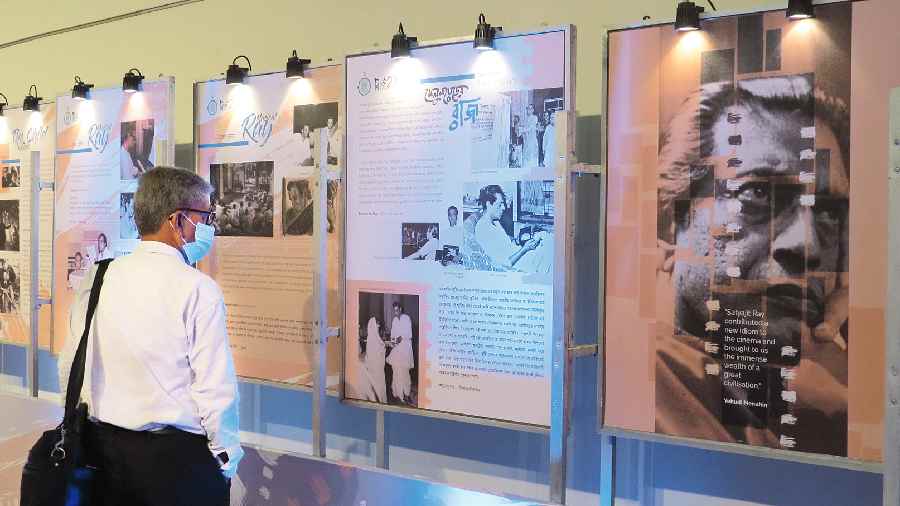The township that has two parks with themes based on his creations — Sonar Kella Park and Professor Shonku Park — is hosting an exhibition celebrating his birth centenary. On Monday, along with the start of the screening of films for the 27th Kolkata International Film Festival, Nazrul Tirtha witnessed the opening of an exhibition titled Satyajit Ray: The Genius of Indian Cinema, which is on view from 12noon to 8pm, till Ray’s birth anniversary on May 2.
Man & his many hats
The exhibition showcases the myriad facets of Ray’s creativity through 48 aesthetically designed panels.
Though Bishop Lefroy Road is known as the cradle of his creativity, it was not until 1970 that he settled there. Starting from Garpar Road, where he spent his childhood, there are as many as seven other addresses which Ray called home at some point in his life. The photographs of each building have been printed with the years of residence indicated in a chart.

Satyajit Ray at work at DJ Keymer
“The texts on the panels are excerpts from accounts that we had asked several luminaries to pen as part of a collection that we have printed. For some others, like Gautam Ghose, Aparna Sen, Madhabi Mukherjee, Sandhya Roy, Sharmila Tagore and Ranjit Mullick, we took short interviews,” filmmaker Sudeshna Roy, who curated the exhibition, told The Telegraph Salt Lake.
Browsing the panels increases one’s acquaintance with Ray. One marvels on learning that he had made Pather Panchali while pursuing a regular job. “I used to shoot on weekends and holidays. I took leave when it would be imperative, at times it would be unpaid leave,” he had said at a lecture from which a panel has used an extract. “According to my father, the ending was brilliant but the beginning could have been better,” Sandip Ray says in another panel on the film.
Barun Chanda, who acted in Seemabaddho, points out that Ray never had any casting director. “…he would often have a specific face in mind and anyone who matched that face would get a sure shot at the role.” He also felt that Ray’s dialogues were simple and easy to deliver.
Recollections are there from several leading ladies in Ray films as well on two panels dedicated to them.
Actors of succeeding generations have spoken about their outlook on the maestro. Saswata Chatterjee, for example, shares his later-day realisation that Goopi Gyne Bagha Byne, “the enchanting fairy tale of my youth is actually one of the greatest anti-war films in the history of Indian cinema”. Parambrata Chatterjee too had had a similar realisation with Hirak Rajar Deshe, that “a fun film” “harbours anti-fascist sentiments”. Gautam Ghose shares his memories of making a documentary on Ray.

Roy, the curator, said the photographs used in the exhibition had been accessed from various archives as also his family collection. One such is of Ray working with other colleagues at DJ Keymer, a British advertising agency where he started his career in 1943. The panel also has a few advertisements he illustrated in those days.
A student of Kala Bhavana, Santiniketan, Ray did exemplary work with book cover illustrations during his Signet Press years. Several have been highlighted, with comments by artist Debasish Deb.
Sketches have also been used from his notebook. We get to see drawings of four looks he created for his iconic sleuth Feluda — in panjabi-blanket-trousers and shirt-jacket-trousers.
Plea for more
Festival chairman Raj Chakraborty and executive committee member June Maliah attended the inauguration which started with a dance recital by New Town CG Block sisters Mrinalini and Mrinmoyee Biswas.

The exhibition being opened at Nazrul Tirtha Sudeshna Banerjee

Film festival chairman Raj Chakraborty speaks
Hidco managing director Debashis Sen recalled requesting chief minister Mamata Banerjee to include Nazrul Mancha as a festival venue. “She had readily agreed. This is the fifth time we are hosting the festival in New Town. This place has the makings of a film appreciation centre, like Nandan,” he said, urging Chakraborty to hold a Ray retrospective in course of the centenary year.
Chakraborty said Nazrul Tirtha could be considered as a venue for a “cine adda”, parallel to the event hosted at the Nandan complex.
Cinematographer Premendu Bikash Chaki pointed out that the films that had come from Cannes were being screened as a package at both Nandan and Nazrul Tirtha. “There are also some select entries here from the screening list at Nandan II and Cinema Centenary Building.”
Free passes are being given out for festival films at both Nazrul Tirtha and Rabindra Okakura Bhavan. A person can collect one pass on the day of the show and of the 11am show scheduled the day after.
